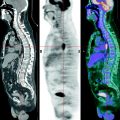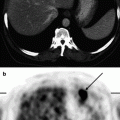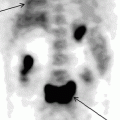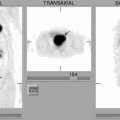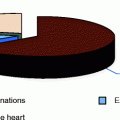, Leonid Tiutin2 and Thomas Schwarz3
(1)
Russian Research Center for Radiology and Surgery, St. Petersburg, Russia
(2)
Department of Radiology and Nuclear Medicine, Russian Research Center for Radiology, St. Petersburg, Russia
(3)
Department of Nuclear Medicine Division of Radiology, Medical University Graz, Graz, Austria
Abstract
Cancer of the testicle is a rare disease which makes up about 1% of all malignant neoplasms in men. Malignant tumors of the testicle are most often observed at the age of 0–4, 30–34 years and over 75 years. In spite of a large number of studies devoted to the epidemiological characteristics and risk factors of testicular cancer, the etiology of this form of tumors is not completely clear (Buetow 1995). Among the main factors favoring the development of the disease there are cryptorchism, traumas of the testicle, genetic anomalies, in particular Kleinfelter’s syndrome, sterility and different kinds of electromagnetic radiation.
Cancer of the testicle is a rare disease which makes up about 1% of all malignant neoplasms in men. Malignant tumors of the testicle are most often observed at the age of 0–4, 30–34 years and over 75 years. In spite of a large number of studies devoted to the epidemiological characteristics and risk factors of testicular cancer, the etiology of this form of tumors is not completely clear (Buetow 1995). Among the main factors favoring the development of the disease there are cryptorchism, traumas of the testicle, genetic anomalies, in particular Kleinfelter’s syndrome, sterility and different kinds of electromagnetic radiation.
In 22–25% of cases testicular cancer develops in men with cryptorchism. During embryogenesis the testicles appear and develop in the abdominal cavity, but by the moment of birth they descend to the scrotum. However, in 3% of children one testicle or both of them either remain in the abdominal cavity or stop their descent in the inguinal area. Implementing a surgical intervention before adolescence in persons with cryptorchism decreases the risk of developing testicular cancer.
Besides that, family predisposition to cancer of the testicle is retraced. Several studies have confirmed that consanguinity of the first degree is a risk factor. The probability of developing testicular cancer is two- to four-times higher for the fathers and sons of patients than it is in the normal male population, and it is roughly eight- to ten-times higher for the brothers of such patients (Heimdal et al. 1996). In men infected with HIV, a high risk of testicular cancer is reported. This risk is particularly high in the presence of clinical symptoms of AIDS. Cancer in one testicle in the history increases the risk of tumor in the other.
In men suffering from infertility, usually hypotrophy or atrophy of the testicles is diagnosed. In these patients a high risk of developing intraductal germinogenic neoplasia is reported, which transforms into invasive cancer within the next 10 years (Jorgensen et al. 1990).
15.1 Pathologic Anatomy and Way of Metastases
The morphologic classification of testicular cancer is based on the characteristics of the types of cells from which tumor develops, namely germinal or stromal cells. Germinogenic tumors (95%) develop from immature germinal cells and epithelium covering seminal ducts. Nongerminogenic tumors are neoplasms originating from hormone-producing cells and connective-tissue of the testicular coat.
They account for 5% of all testicular cancers. Germinogenic tumors are divided into seminomas and nonseminomas. Seminomas make up about one half of all testicular tumors. Tumors of the nonseminomatous type are divided into teratomas, choriocarcinomas and embryonal cell tumors (tumors of the vitelline sac). Embryonal carcinomas are more often observed in boys and remind embryonal carcinomas of the ovary in their structure. The morphological texture of teratoma is represented by two or more types of germ cell layers. The term “teratocarcinoma” refers to a mixed nonseminomatous form of testicular cancer, consisting of teratomatous components and those of embryonal cell cancer.
Seminomas usually are composed of cells of one and the same type, while nonseminomatous tumors may be both mixed, i.e. consisting of seminomatous and nonseminomatous components, and purely nonseminomatous. Mixed tumors make up about 40% of all germ cell tumors.
Tumors of the gonadal stroma make up 5% of all testicular cancers and are represented by Leydig cell tumor, Sertoli cell tumor and granulous cell tumor.
The stages of the disease are distinguished according to the TNM classification.
The classification is used only for germinogenic tumors of the testicle.
Local spread of testicular cancer manifests itself with tumor invasion into the epididymis, spermatic cord and tunica of the testicle. It should be noted that the primary tumor lesion may be located in other organs or tissues, most often in the mediastinum and retroperitoneum. Extragonadal tumors develop as a result of aberrant migration of germ cells during embryogenesis or are formed from predecessor cells originating also cells of the thymus.
Lymphatic metastases occurs to retroperitoneal lymph nodes, more seldomly to inguinal, pelvic or mediastinal lymph nodes. The regional lymph nodes for the testicle are paraaortal, preaortal, interaortocaval, paracaval, precaval, retrocaval and retroaortal nodes. Intrapelvic and inguinal lymph nodes are considered as regional if operations on the stratum and inguinal area were previously done. In testicular cancers it is ipsilateral lymph nodes that are usually affected. Sometimes bilateral and cross-metastasis is observed conditioned by anastomoses between lymphatic vessels.
Hematogenic metastases are most often observed in the lungs, liver, brain and kidneys.
The earliest symptom of testicular cancer is appearance of tumor mass in the scrotum and tumescence of the scrotum. In some cases, tumor is not accompanied by symptoms until it reaches a large size. Usually the tumor is painless; however, with its growth, pain in the testicle and along the spermatic cord appears. In case of hormonally active tumor, a change of secondary sexual characters is observed: appearance of gynecomastia, early puberty, hirsutism, etc. In 10% of cases the first symptoms of the disease, i.e. intensive drawing pain sensations in the area of the loin are conditioned by tumor metastases to retroperitoneal lymph nodes.
15.2 Methods of Diagnosis
Primary diagnosis of testicular cancer consists of examination and palpation of the stratum, inguinal lymph nodes, and mammary glands. Diaphanoscopy, X-ray examination of the stratum with a narrow light beam, permits to differentiate a non-transparent tumor from a cyst.
An important contribution to diagnosing germinogenic tumors of the testicle belongs to study of serum tumor markers – alpha fetoprotein (AFP), human beta-chorionic gonadotropin (b-CG) and lactate dehydrogenase (LDH). Higher level of AFP and/or b-CG is observed in about 90% of patients with nonseminomatous testicular tumors. However, the normal level of tumor markers does not exclude the disease (Albers et al. 2005). Determining the level of serum tumor markers helps diagnose testicular tumors at early stages, diagnose extragonadal germinogenic neoplasms and is of significant aid in discerning relapses and in refining prognosis.
Alpha-fetoprotein (AFP) belongs to the group of the oncofetal antigens and is a structural analog of albumen. In the embryonal period it is secreted in the vitelline sac, liver and gastrointestinal tract of the fetus. In the early stages of fetal development AFP replaces albumen and performs its transport functions. At the age over 1 year old, the upper limit of the norm of AFP concentration in blood serum corresponds to 15 ng/mL.
Stay updated, free articles. Join our Telegram channel

Full access? Get Clinical Tree


